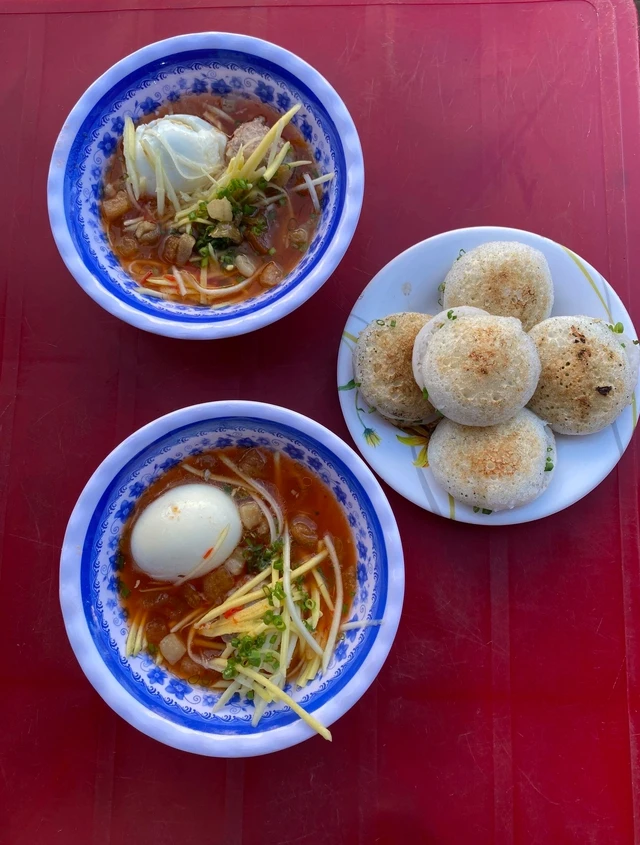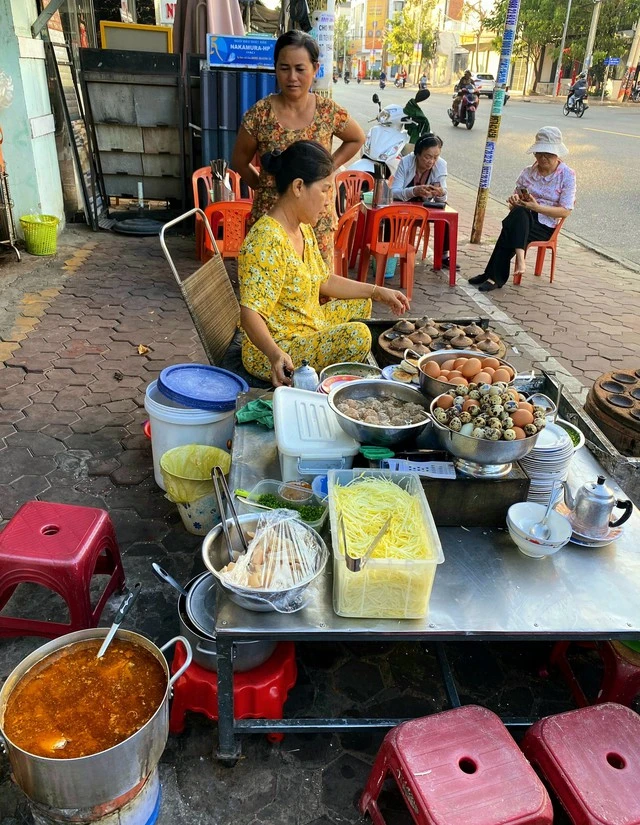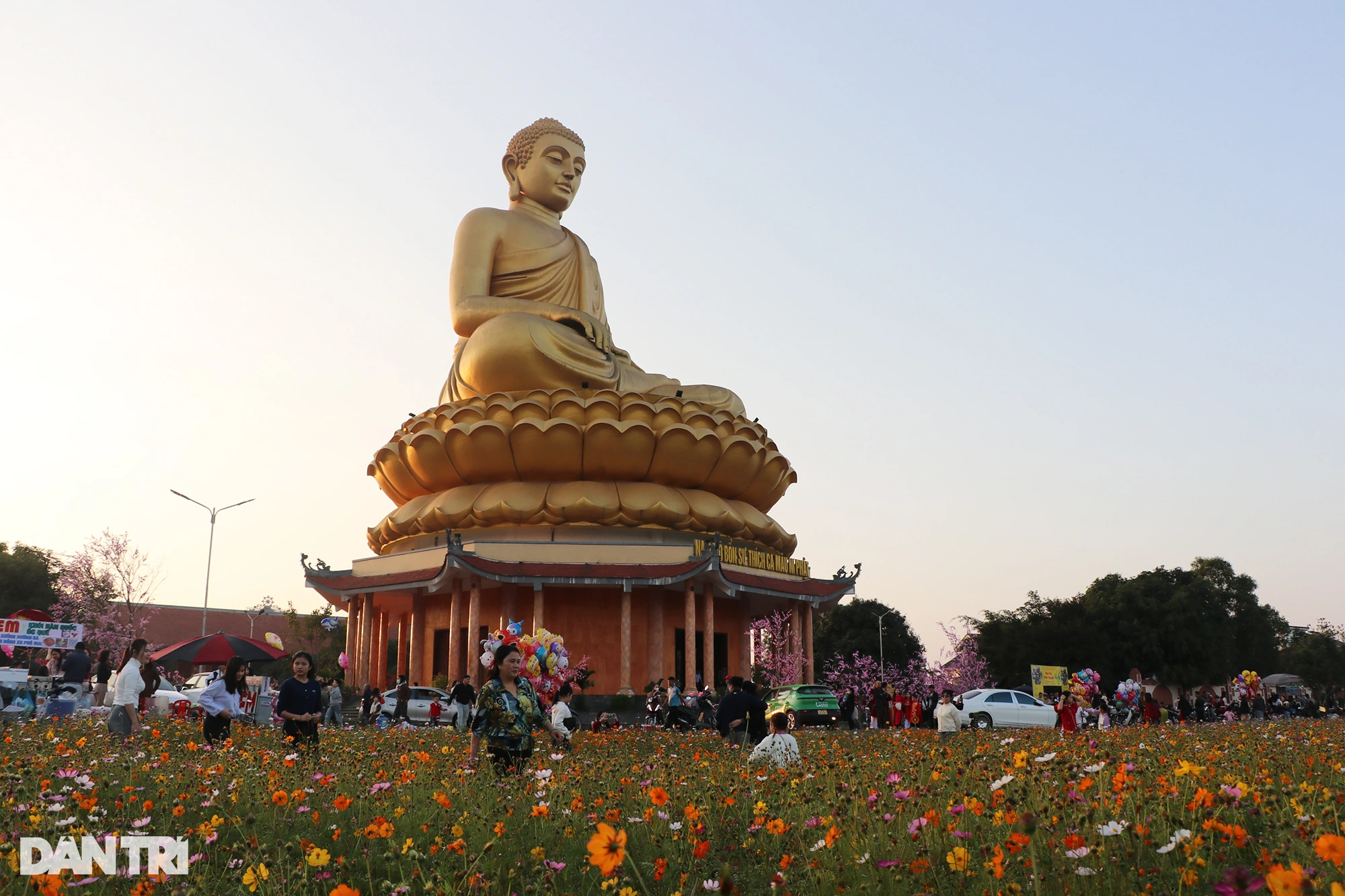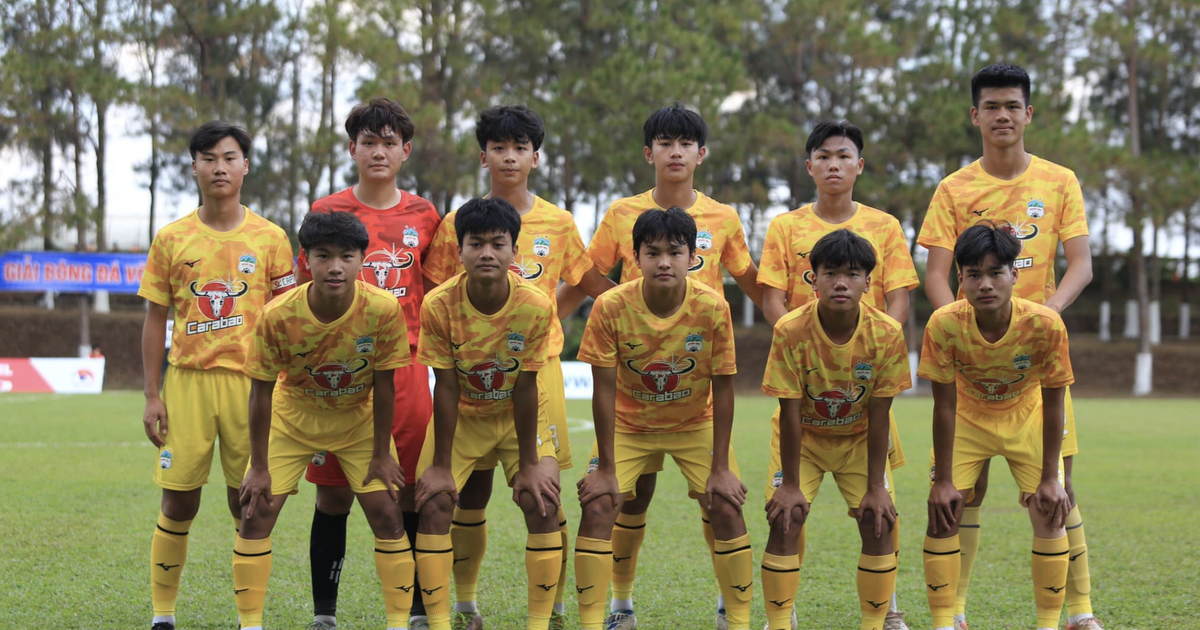1. "What are the specialties of Phan Thiet - Binh Thuan?". I don't dare to confirm, but if it is a favorite dish, eaten since childhood, and when away from home, I miss and crave it, then I can answer right away: Quang noodles and banh can.

Phan Rang, Nha Trang, Da Lat... also have banh can, but the one with the most "complex" side dishes is probably Phan Thiet banh can.
For locals, these are two simple, familiar dishes. For visitors from far away, they are quite "strange", even somewhat controversial, although they are on the must-try list for a Phan Thiet food tour.
People in Phan Thiet can eat Quang noodles and Banh Can at any time of the day. People also often cook it themselves without having to go out to eat, suitable for large families, gathering to eat together. However, Quang noodles and Banh Can are... absent in parties, for example, at death anniversaries in Phan Thiet, people often make Banh Xeo instead of Banh Can, cook curry or La Gu instead of Quang noodles. Another strange thing is that even though it is located in a coastal area, there is little "sea" quality in these two dishes.
I want to talk about Quang noodles and Banh Can in Phan Thiet as I know it, within the inner city area. Going a little further, for example Ham Tien, Mui Ne, is also Phan Thiet, but the food is somewhat different, let alone...
2. Phan Thiet Quang noodles are... Quang noodles, not Quang noodles in Quang region, which is Quang Nam today. If "Quang people eating Quang noodles" - according to the title of the book by writer Nguyen Nhat Anh - is already very... picky, then it is impossible to imagine what it would be like when "Quang people eating... Phan Thiet Quang noodles"! They have the same name, but are worlds apart. I intentionally capitalized the word "quang" to distinguish the two noodle dishes.
Some people call Phan Thiet Quang noodles "duck Quang noodles" to make it easier to distinguish, but that's only half true, because the other half is... pork Quang noodles, which is even more popular. Duck meat used to cook is usually the thigh quarter, head, neck, wings, heart, gizzard... The pork meat chosen is usually ham (ham bao), ears, nose, cutlets, sliced meat (lean pieces with a border of fat and skin)... Completely different from the "filling" of Quang noodles which can be cooked from chicken, frog, shrimp, fish, eggs...
Duck and pork cooked with Quang noodles are marinated with garlic, chili, sugar, annatto oil... The garlic and chili help to clearly distinguish the flavor between Phan Thiet Quang noodles and Quang noodles - which use shallots and peanut oil to cook.
The two noodle dishes are different in many ways, but especially the broth: Quang noodles are just poured over the top, on the contrary, Phan Thiet Quang noodles are a hot soup-noodles-dish, similar to pho, bun bo, hu tieu..., meaning the bowl of noodles must be filled with warm broth, otherwise it will not be delicious if eaten cold.
I used to believe that Phan Thiet Quang noodles were influenced or adapted from Quang noodles of Quang region, but recently, having the opportunity to enjoy braised ribs in Chinese dim sum restaurants in Saigon, I found them quite similar! Could it be that "Quang" in Quang noodles does not refer to "Quang region", but to "Quang Dong", that is, Chinese people? It is important to remember that in Phan Thiet, especially in the central area, there is a group of ethnic Chinese who have settled there for a long time, and according to statistics, half of them are Chinese of Cantonese origin. So the hypothesis that Phan Thiet Quang noodles originated from Chinese dishes is well-founded...
3. Phan Rang, Nha Trang, Da Lat... also have banh can, but the most "complicated" side dishes are probably banh can Phan Thiet.
To make banh can, people soak rice and grind it into a liquid dough - not too thin or too thick so that the cake does not get soggy or burnt. When mixing the dough, add a little cold rice. Some say it makes the cake spongy, others say it makes the cake crispy or... chewy (?!).

A banh can restaurant in Phan Thiet city
The banh can oven is made of baked clay, round like a table top, with about 10-16 holes, and charcoal is burned underneath, and small molds like shallow cups with lids are placed on top. Sellers often use... teapots to hold the dough, making it easier to pour into the molds. The banh can stalls look crowded, because the person pouring the cake has to sit on a low stool next to the oven, which is rarely raised high.
When the cake is pitted on the surface and the bottom is golden brown, it is removed from the mold and gently tossed face down into a basket of chopped green onions so that the onions stick evenly on the inside of the cake. Every two upside down make a pair, 5 pairs make a plate. Banh can is a "baked" type, completely different from banh xeo, banh khot, and banh khoai in that it is "fried" with oil.
Phan Thiet people like to eat white cakes, with no flour. The type of cake covered with beaten eggs like Da Lat today, I remember it used to be called "special" cake, still exists but is not popular. The type of cake with shrimp, squid, beef... in the middle like Phan Rang, Nha Trang is also not popular.
Each person is served a bowl of very diluted fish sauce, not too salty but sweet, Phan Thiet style means "you can slurp it up", with some chopped mango, some restaurants also add star fruit, some pork fat made from pork fat, or "fake" bread with pork fat, which is also quite popular in Phan Thiet.
That’s not enough. Usually you have to add half a boiled chicken/duck egg, a few small quail eggs, meatballs, steamed pork skin. And soft braised fish, usually mackerel, gills removed, head and belly removed, braised Phan Thiet style.
As you eat, pour the banh can into the bowl.
In Phan Rang, banh can is served with 4 types of sauce: fish sauce, fermented fish sauce, peanut sauce, fish sauce, diners can mix them all as they like. In Da Lat, banh can is eaten with meatballs and leaf-wrapped sausage. Phan Thiet does not have that.
4. Both Quang noodles and Banh Can mentioned above have something in common: quite... sweet. Quang noodles are easy to notice, especially in the broth, while Banh Can has a faint taste somewhere, maybe in the fish sauce, meatballs, braised fish... Not just these two dishes. That is the characteristic sweetness in Phan cuisine in general, all dishes are the same. Everyone finds it sweet, except... Phan Thiet people. Because of this sweetness, many tourists "refuse" or even "dislike" the dishes, making many Phan people... upset.
Some people try to explain this unique sweetness in Phan Thiet culinary culture but cannot come to a conclusion. It is not "sweet with MSG", nor is it "sweet with coconut milk". Is it to balance the salty taste of this coastal region, people eat sweet?
I guess it is that sweetness that makes Phan Thiet people miss and crave their hometown food when they are far away. Even in a place where four regions converge like Saigon - Ho Chi Minh City, according to my observation, it is difficult to find "standard" Quang noodles or Phan Thiet banh can. Perhaps only when you go back to your hometown to eat it will you find it delicious! Probably due to inherent conservative feelings.
Writing up to here, suddenly I crave Quang noodles and banh can from my hometown...

Source link




















































Comment (0)